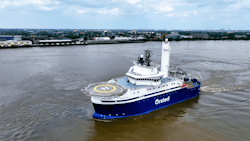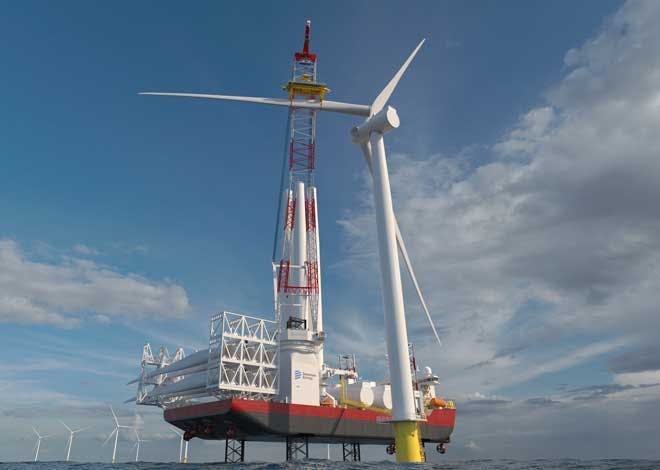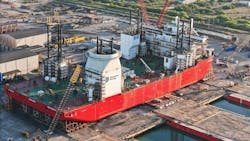US vessel newbuilds are Jones Act compliant, ready for offshore wind market
Editor's note: This feature first appeared within the 2024 Offshore Wind Special Report and published within the July/August issue of Offshore magazine.
By Ariana Hurtado, Editor and Director of Special Reports
The Jones Act stipulates all transportation between American ports may only be provided by US-flagged ships that are constructed in the US and owned by US citizens. Offshore wind developers can bring in construction vessels from elsewhere, but they cannot transport cargos between ports. Therefore, Jones Act compliant support vessels are needed to enable the transfer of cargo from port to project site. According to ABS, this US offshore wind build-out will require more than 110 US vessels to meet 30 GW by 2030.
First US-built SOV
Ørsted reported in April that its purpose-built ECO Edison service operations vessel (SOV) was nearing construction completion at the Edison Chouest facility in Houma, Louisiana. The 260-ft-long ECO Edison is the first US-built SOV for the American offshore wind market. The vessel was later christened at the Port of New Orleans on May 11. As of June, the ECO Edison was heading to Rhode Island to begin its operations to support offshore wind.
The SOV is compliant with the Jones Act, which is a key requirement for the vessels that Ørsted will use throughout the lifespan of its US offshore wind farms. The vessel will service Ørsted’s offshore wind farms in the northeast US region, including construction of the Revolution Wind and Sunrise Wind projects. During these projects, the vessel is expected to house the company's wind turbine technicians, featuring space for 60 crew members.
Edison Chouest Offshore, Ørsted and Eversource first executed a long-term charter agreement for the US-flagged SOV in October 2020. Earlier this year, however, Eversource signed a deal to sell its stake in the South Fork Wind and Revolution Wind offshore projects, which completed the utility’s exit from the offshore wind sector.
Last year Edison Chouest Offshore’s Louisiana shipyard also started constructing what it claims to be the US offshore wind sector’s first mini-crew transfer vessel (CTV). The 12-m-long vessel, designed by Chartwell Marine and capable of transporting up to 12 personnel, is due to start operating this summer for Ørsted. It was originally scheduled to accompany the launch of ECO Edison. The CTV/daughter craft onboard the SOV can be deployed to take crews across the under-development Revolution Wind, South Fork Wind and Sunrise Wind offshore wind farms. The CTV will incorporate various components from US suppliers.
First US-built WTIV
Ørsted also has contracted Dominion Energy’s Charybdis wind turbine installation vessel (WTIV) to support the construction of the Revolution Wind and Sunrise Wind offshore wind projects. The Charybdis is the first vessel of its kind to comply with the Jones Act.
Blue Ocean Energy Marine, a subsidiary of Dominion Energy, was formed to construct and operate Charybdis to support the development, installation and maintenance of US offshore wind projects. Dominion Energy had the Charybdis built in the Seatrium AmFELS shipyard in Brownsville, Texas. Fagioli Inc. transported the Charybdis WTIV, weighing 23,163 tonnes, from the port facilities onto three barges from where it was subsequently launched into the water on April 15. The vessel launch was also the world's largest completed lift totaling 23,000 tons.
The vessel's hull and infrastructure was fabricated with more than 14,000 tons of domestic steel, with nearly 10,000 tons sourced from Alabama, West Virginia and North Carolina suppliers. The vessel is designed to handle turbine sizes of 12+ MW.
Dominion plans Charybdis sea trials in late 2024/early 2025 as well as offtake of its Coastal Virginia Offshore Wind (CVOW) project in 2025-2027. The CVOW project received a final construction air permit in April from the US Environmental Protection Agency, which was the 11th and final federal permit required to begin offshore construction. Offshore monopile installation was scheduled to begin in May, and CVOW project construction and commissioning will take place 2024-2026.
About the Author
Ariana Hurtado
Editor-in-Chief
With more than a decade of copy editing, project management and journalism experience, Ariana Hurtado is a seasoned managing editor born and raised in the energy capital of the world—Houston, Texas. She currently serves as editor-in-chief of Offshore, overseeing the editorial team, its content and the brand's growth from a digital perspective.
Utilizing her editorial expertise, she manages digital media for the Offshore team. She also helps create and oversee new special industry reports and revolutionizes existing supplements, while also contributing content to Offshore's magazine, newsletters and website as a copy editor and writer.
Prior to her current role, she served as Offshore's editor and director of special reports from April 2022 to December 2024. Before joining Offshore, she served as senior managing editor of publications with Hart Energy. Prior to her nearly nine years with Hart, she worked on the copy desk as a news editor at the Houston Chronicle.
She graduated magna cum laude with a bachelor's degree in journalism from the University of Houston.



